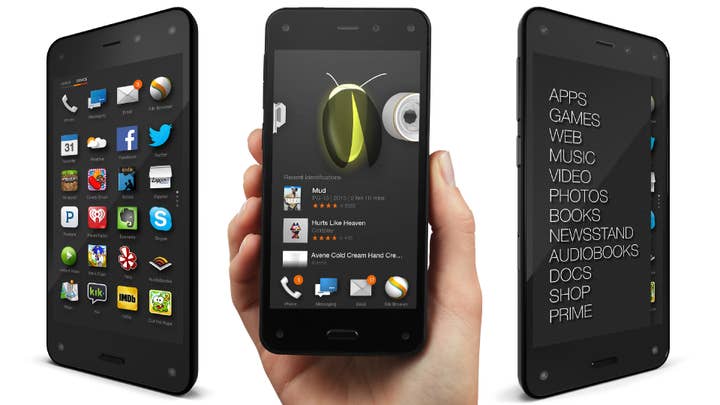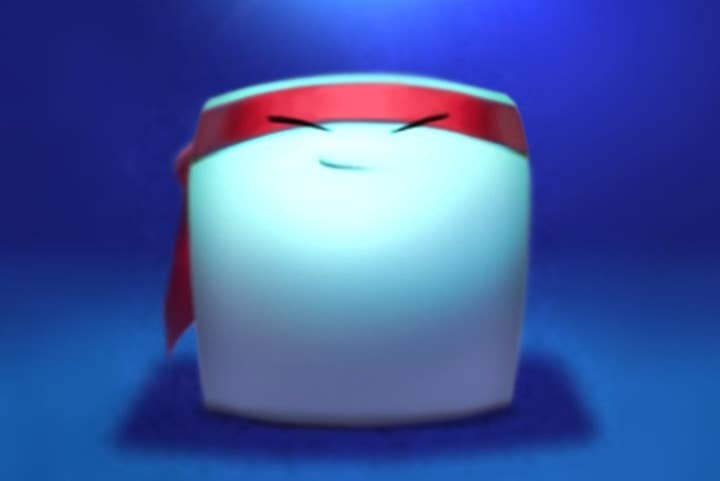The new burning platform?
To-Fu Fury dev HotGen on the launch of Amazon's Fire phone
Amazon, as I cannily observe to HotGen's Terry Haynes and Darren Anderson, is a pretty big deal. On the whole, it does OK.
That's the sort of scintillating insight you get from sitting down with a specialist business journalist, I suppose, but Haynes and Anderson won't be distracted by my priceless insights - they're far too engaged in showing off their new game To-Fu Fury on the dev unit of the new Amazon Fire phone, launching in the US this Friday.
Senior producer Anderson is the one holding the handset, excitedly swiping his way through To-Fu Fury's menus and intro screens, eager to show me what new tricks the Fire can deploy in the mobile battlefield. It's not long before he has me swooping my head around like an idiot, using the handset's four-camera head-tracking system to peek around the corners of the game's levels.
"Obviously it'll have a lot of use for gaming features," he tells me when I ask if it's just another way of selling you things. "It's not just looking at the position of your head, it watches gestures too. If you see something you're interested in and look at it, the phone recognises what part of the screen you're looking at. We've only spoken about it rather than seen it working, but I believe you'll be able to look at a button, say on the Amazon store, and it'll register your interest and pop up some info.
"I kind of see it as being akin to when the stylus came out for the DS"
"We use it in our game to be able to look around the level. The game's rendered in 3D but has a 2D plane. Using this you can peek over towards the edge of the screen to see where you're going.
"I kind of see it as being akin to when the stylus came out for the DS. It opened it games up. Joysticks are a bit of an alien device, but if you give someone a pen, they've been using that all their life, they know how it works. In those terms I think it's a new interface paradigm for the mass market. I think that's where Amazon is on to a winner. It's down to developers to make the most of the functionality."
As a largely 2D platform puzzler, To-Fu Fury isn't the most obvious game to show off the new machine's capabilities, but it's actually a good example, with the subtly shifting rendered backgrounds of the games levels sliding neatly around as I weave my head back and forth in front of the test-unit's screen. It's a little reminiscent of the iPhone 5's wallpaper tilting, but with no need for accelerometers, even working well when a journalist's chubby fingers cover a couple of the forward-facing cameras.

There are other uses than peeking around corners, too. Anderson tells me that the release phone will zoom in as users move their heads closer, for example, and track eye movements.
"I think the use of it will just get better and better," he says with enthusiasm. "Obviously we're first wave, so I think there's more we could have done, knowing what we know now. I feel like we've underutilised the features a bit, to be honest. We're still very proud of what we've done, though. The game stands alone as it is."
So how do you get your game in at launch for new hardware from one of the world's biggest companies?
"We started talking to Amazon at GDC last year, before there was any mention of the device publicly," CEO Terry Haynes chimes in. "That conversation went on - they'd seen Tofu 1 and 2 on iOS, where we'd had over five million downloads, so we had awareness of the IP. We wanted to take it up a notch, to take it to a new platform.
"From our point of view one of the key things is that Amazon as a brand is so consumer-driven. One of the points Jeff Bezos made during the presentation was that the Mayday button means you're only ever 15 seconds away from support. That's all about how you treat the consumer, making them your number one concern. We felt that we wanted to be a part of that at launch.
"My personal feeling is that the loyalty Amazon has is going to help hugely. Almost everyone I know has used them at some point, Prime is a great thing. It's all about convenience. For us, being involved in the launch was a no-brainer."

Whilst it might have the wealth of some continents, Amazon isn't exactly known as a corporation overflowing with artists and creative beauty. It has, however, been quietly hoovering up very talented designers, like Kim Swift, to head up new games teams throughout the company. Is Haynes convinced that they're taking gaming seriously?
"The people we met were almost all from a gaming background. People from Activision, Microsoft etc. Products like Call of Duty, Halo, Half Life. They've come from huge IP. They want to work with us to make a great game. There are always little hurdles to get over, but those guys are there to talk to. They look at it, no-one wants to hide it away. They want to find solutions, they give us tons and tons of support.
"They've got a really good attitude of 'let's make games.' They want us to have a success, they want to help. As soon as a company gets huge, people assume they must be at least partly evil, but we've not seen any of that. They're a cracking bunch of people."
"It's still embryonic for them, because they're still building up their systems and processes," qualifies Anderson. "Every time they roll something new out, they always ask if anyone thinks there's a better way to deal with it. They put bums on seats to help us. We've all been in situations where a publisher has wanted something done differently, but their sole contribution to that has been to tell you so. They'll look at it, see if you're able to prioritise it and give you a coder to put on it if not.
"The people we met were almost all from a gaming background. People from Activision, Microsoft etc. Products like Call of Duty, Halo, Half Life. They've come from huge IP"
"It's just like their approach to the customer: they want the experience to be as seamless and profitable as possible."
Fury itself is pretty, slick and easy to control, with a satisfying main gameplay loop and a loyal existing audience. Being one of the first games on the platform should bring it plenty of exposure anyway, but has HotGen secured any special treatment?
"We'd like to think so," laughs Haynes, "but that hasn't been finalised at the moment! It's one of the first games out on a new device that really uses the hardware. Obviously, it's an Android device, so you're going to get your Candy Crush and Angry Birds too, but we'd like to think this'll be up there."
If you're in the US, you'll be able to experience the fruits of HotGen's labours this week, when the Fire Phone launches this Friday.

